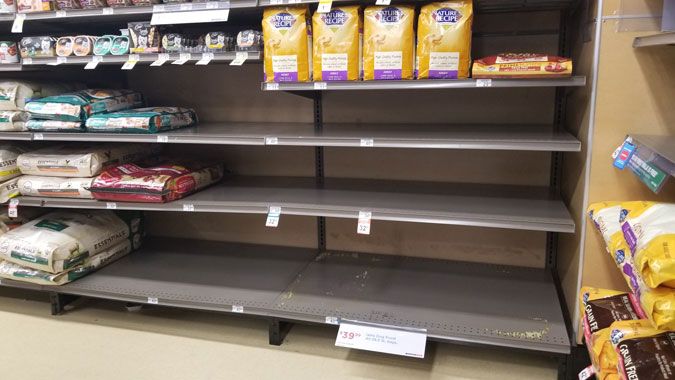I read an article the other day about a pork processing plant in Sioux Falls, South Dakota, shutting down due to hundreds of workers becoming infected with COVID 19; at the time the article was published, 293 of the 730 people in South Dakota who had been diagnosed with COVID-19 [as of April 12, the number has increased] work at the plant.
My very first thought was not “OMG, how will this affect my bacon supply?” but, “OMG, I wonder how the dog food companies are faring.”
Pet Food Production Is An Essential Service
Food production is an essential service – even pet food production. But any manufacturing plant brings people close together and can be a vector for transmission of a virus. That said, in my experience, it takes far more employees to operate a meat-packing plant than a pet food manufacturing plant, and the employees who work on the butchering and packaging lines work far closer together than employees at pet food manufacturing plants.
So far, we’re not seeing any reports of pet food companies slowing or stopping production. Pet food manufacturers might be more hampered by ingredient shortages than manpower shortages, at least in the short term – and so, at some point in the next few months, some of us might be unable to find our dogs’ favorite food when we run out.
The U.S. Food and Drug Administration (FDA) released a statement regarding the actions it is taking to safeguard the food (and pet food) supply, and assuring the public that empty shelves are due to unprecedented demand, not a lack of capacity to produce, process, and deliver food. The pet food industry trade publications, too, report that while manufacturers are taking steps to protect the health and safety of their workers and their products, for the most part, the pet food producers are, if anything, increasing production to meet demand.
The coronavirus crisis has increased pet food demand
And demand has been high. Pet trade industry publications confirm that consumers definitely stocked up on pet food in March. Petfood Industry conducted a poll of pet food companies, and reported that 52% of 81 respondents stated that sales increased substantially since the onset of the COVID-19 pandemic. Another 28% reported that sales had increased “somewhat.”
A different trade publication, Pet Food Processing, also conducted a poll of pet food manufacturers, and reported that 63% of respondents said they had seen an increase in demand for their products.
None of us want to be caught short of food for our beloved animal companions – hence the stocking up. But I want to remind owners that while processed pet food has a very convenient shelf life, it’s not indefinite. Dry food, in particular, degrades over time, with the fats in the food becoming increasingly rancid.
Dog food has a limited shelf life
Most dry dog foods are sold with a “best if purchased by” date that’s about 9 months to 18 months past its date of manufacture; 12 months is average. Natural preservatives such as “mixed tocopherols” (vitamin E) or ascorbic acid (vitamin C) don’t prevent rancidity as long as artificial preservatives such as BHA, BHT, or ethoxyquin, but these synthetic preservatives have been associated with adverse health effects. The foods that are preserved with these synthetic chemicals will last the longest (and be labeled with the most distant “best by” dates), but, in general, these products also tend to have additional attributes that will disqualify them from WDJ’s “approved foods” lists.
Canned foods, of course, last a lot longer, entirely without preservatives. They are much more expensive, however. Same with freeze-dried and frozen foods.
Buying an extra bag or two, or even a couple months’ worth of food in advance, might help you reduce the number of trips you need to make out of your home, but please don’t go crazy and buy a year’s worth of food. I guarantee that, by the time you feed the last of it, some of it will be degraded and rancid enough to give your dog chronic diarrhea.
Don’t forget to switch your dog’s food
Instead, practice the same kind of flexible feeding that we have always recommended; if you frequently switch the brand and varieties of food you feed your dog, it won’t be a problem if one or more of your favorites is temporarily unavailable. In a pinch, I’d probably advise feeding a fresher, lower-quality food than a really old, super high-quality food, even if the bag had been kept in the ideal cool, dry, dark storage place for the entire time (and how many of you even have a place like that year-round for food storage?).
The only exceptions? Those of you whose dogs have severe food allergies and need to feed a rigidly controlled diet that doesn’t vary. If this describes you and your dog, you have my utmost sympathies. You probably already have secured a supply of your dog’s food that will last at least a month or two; just try not to go crazy and buy a whole year’s worth.
Keep taking those dogs and yourselves for daily walks! Now, more than ever, we all need them for health.







We have not seen any concerns yet locally but having an extra couple of weeks in the pantry is a good plan.
I live near a volcano and in earthquake territory. I always have a rotating supply of dog food (different brands and “flavors”) for up to four months. A natural disaster is more likely to immediately disrupt supplies than a pandemic so I’m always ready. But it is constantly rotating so the food is never in cool, dark storage longer than 4 months before it is used and replaced by a new bag. This is a long term habit to be prepared for the unthinkable. My pet food stores in my area are doing fine with supplies of all types of food during the pandemic so that’s good news.
Pork from a plant like the one you describe in S. Dakota *is* what I feed my dogs, together with chicken, beef, duck, and the occasional rabbit…so that story got my attention. I’m praying for the safety and health of the workers, and for some kind of safe return to work for them…
I stocked up three months of dog food in March because it takes 1 hour to get dog food. I look at the expiration dates carefully now, especially discovering 2 expired bags of food ($150). Thank goodness, I was still at the parking lot, and returned the two bags immediately, and gave the store a hard time about selling expired dog food. I was so upset with the store, and its poor practice. I rotate flavor and brand – just in case.
I sell only two brands of kibble, focusing more on frozen raw foods. We’re a dog day care/grooming and training facility, chiefly focused on services. But my care in selecting kibbles reflects my general horror at the state of the pet food industry. In 16 years in business, I have dumped anchor brands 5 times for what I consider betrayals of consumer trust. The first week of the panic, customers cleaned us out. I ordered double the following week, but next the state decreed we must halt grooming as a non-essential. Day care was allowed, but reduced to serve the dogs of other essential workers. Overnight our revenues shrunk to about 25% of normal, as training classes also had to halt. For the last 3 weeks, food sales have bottomed out. I do not have the kind of reserve to afford normal stocking if people aren’t buying. I do understand the panic and the urge to have a cushion. But try not to give in to the urge to hoard. The kind of buying dynamics there will kill small, ethical stores. We just learned we will receive one of the PPP loans, so we will likely survive. But think how your purchasing and consuming pattern disruptions affect the vendors you depend on, as well as your immediate situation. This is another reason why I have always coached my customers in how to feed their pets entirely from whole foods available in grocery stores. Whether they do it often or only sometimes, having that knowledge is better than having a stockpile!
Please educate us also on how to feed pets from whole foods available in grocery stores.
Would love to learn some healthy diet to feed my dogs from human food
I feed my dog a special prescription diet due to her kidney disease. She’s a Chihuahua and I only need to get a few cans at the vet’s every 2 weeks. Because of the lockdown, the vet is suggesting that patients get their food by mail order to avoid a trip to the clinic. The supplier only sells the food by the case, not individual cans, so now I’ve got enough to last her for 4 months or so.
I SO Rely on your timely and relevant Blogs to keep me up to snuff FAST to keep my dogs Safe at All times. Just want to say Thank YOU for staying So quickly current on everything relating to our dogs and their (and our) environment! Even with having an excellent vet, your day-to day sober insights into everything dog, and the many resources you make available are so invaluable. It helps to remove the fear of “the unknown.” I know I would be living with a far greater undercurrent of worry and stress without you and Whole Dog.
Great post! We are starting to make our own fresh, homemade dog food which helps in times like this and is less expensive. We also order most of our dog and cat food online…hoping to stock up now!
What recipe are you using, please? I’m about to start making my miniature poodles homemade food and trying to figure it out, what vitamins, etc. Thank you.
Thank you.
Thank you for this. It was very helpful. We have a 1 year old puppy/dog and we are constant;y changing her food but also stocking up food for times like these.
I haven’t been able to get my regular cat food at all. Fortunatlly she;s really not that picky so we’re lucky there. However
I have an older dog with pancreatitis and now Royal Canin is out of stock on iher food.t I don’t really have a choice with her, she’s already been to ER for something she ate, don’t need another one of those trips.
I think it’s just an excuse to raise the prices – the shelves are bare in the northeast – get it together the pandemic has been going on for 2 years – at this point it’s an excuse